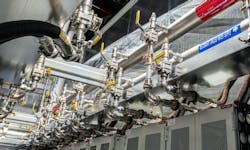Liquid Cooling Heats Up Competition Between Colocation Data Center Providers
Liquid cooling technology is coming into its own now, as the largest colocation data center operators in the world are making it a standard part of their services offerings.
With an increase in the demand for high rack density and the ability to provide adequate cooling, driven primary by the rapid adoption of power and cooling hungry generative AI hardware and applications, Equinix this week became the latest top-level colocation provider to make liquid cooling a standard part of their service offerings.
The addition of direct-to-chip cooling solutions to their existing liquid-to-air cooling offering will increase the capabilities of the Equinix IBX data centers that will be offering this option. The operator said they now support direct-to-chip liquid cooling in data centers in more than 45 metros across all three of their global regions, the better to power compute-intensive workloads such as AI.
All Equinix data centers currently offer air-to-liquid cooling options, in the form of in-rack heat exchangers. The addition of the direct-to-chip cooling option significantly expands the cooling capabilities of the facilities so equipped.
The How-To of Cooling
The direct-to-chip options being offered work with existing rack designs; Equinix is providing the infrastructure to support the deployment of liquid cooling through the facilities. Rear door heat exchangers, which are an air-to-liquid rack cooling solution, are already supported by their data centers.
My Truong, Sustainable and Scalable Infrastructure Alliance Chairperson and Field CTO for Equinix, pointed out that liquid cooling was a primary concern in developing the latest Open19 V2 specification.
Truong said, “The goal of the Open19 project, which operates under the Linux Foundation, was to create an open standard that can fit any 19" rack for server, storage, and networking. The project enables digital leaders to use hardware from a diverse set of vendors efficiently and sustainably in any datacenter environment. Equinix's technology and vendor neutral approach to liquid cooling is a mechanism to remove the friction of deploying advanced liquid cooling solutions in enterprise data centers."
As a standard, the Open 19 project cabinets are designed to support up to 60 kW of IT workload, and are currently deployed in more than 20 Equinix sites worldwide.
The V2 standard was designed to simplify IT deployment by integrating power, network and liquid cooling connections at the rear of the cabinet, while permitting plug-and-play server installation from the front of the cabinet
In keeping with these goals, the liquid cooling support being offered is vendor neutral, allowing Equinix customers to continue using the hardware providers with whom they are comfortable and familiar.
The greater availability of the direct-to-chip liquid cooling technology support should not come as a surprise. Almost 18 months ago we noted that Nvidia announced liquid cooled GPUs that would be a standard offering with Equinix as an early adopter of support for the technology.
This implies that Equinix has had more than a year to evaluate the liquid cooling technology and refine its operation to allow it to become a standard offering for its colocation customers.
Broad Cooling Technology Support is a Key Component
At the kickoff meeting in October for the DOE COOLERCHIPS program, Equinix discussed the two types of direct to chip liquid cooling they were using. The two styles being deployed were described thusly:
- “Negative Pressure” - Single-phase cold-plate by Chilldyne, which uses their innovated negative pressure technology to pull liquid through the cooling system to minimize the chance of a fluid leak in the system being cooled.
- “Refrigerant” - Two-phase cold-plates system by ZutaCore, which uses a two-phase, closed loop, boiling and condensation process to move heat off the chips.
While these were two cooling technologies that were discussed at the conference, it is likely, given their vendor neutral approach, that direct-to-chip cooling solutions from other providers will be suitable for use.
Given that earlier this year, Digital Realty announced that they would be supporting up to 70 kW per rack at 28 of their colocation facilities, it would be safe to presume that these are just the first steps in the battle to deploy better cooling and higher rack densities at colocation facilities worldwide.
For its part, wholesale data center giant CyrusOne also this year prominently announced a liquid-to-chip cooling option for its Intelliscale AI deployments. The company said its modular manufacturing approach to data center development enables customers to utilize liquid-to-chip cooling technology, as well as rear door heat exchanger cooling systems, and immersion cooling to achieve efficient cooling up to 300kW per rack for AI workloads.
"Equinix has the experience and expertise to help organizations innovate data center capacity to support the complex, modern IT deployments that applications like AI require," concluded Tiffany Osias, Vice President of Global Colocation, Equinix.
"Liquid cooling is revolutionizing how data centers cool powerful, high-density hardware that supports emerging technologies, and Equinix is at the heart of that innovation," Osias said. "We have been helping businesses with significant liquid-cooled deployments across a range of deployment sizes and densities for years."
In this video, Equinix Field CTO My Truong explains how the data center operator is using ZutaCore dielectric liquid cooling on their production servers.
About the Author



